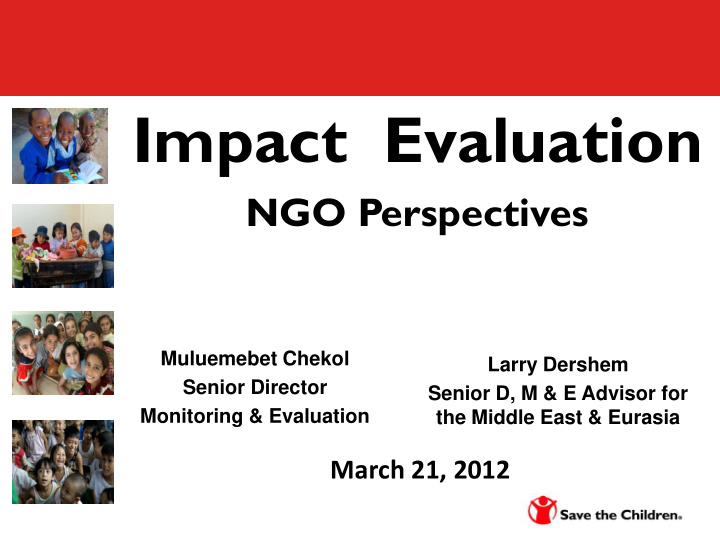



Impact Evaluation NGO Perspectives Muluemebet Chekol Larry Dershem Senior Director Senior D, M & E Advisor for Monitoring & Evaluation the Middle East & Eurasia March 21, 2012
How does Save the Children define Impact and IE? • IMPACT: the totality of effects produced by an intervention, whether they be positive or negative, intended or unintended, direct or indirect, primary or secondary. In emergency interventions, effects may be assessed in terms of outcomes rather than impact . • IMPACT EVALUATION: an evaluation of effects (both intended and unintended) that can be attributed to a specific program, project or policy. Impact evaluations help inform policy and decision making as to what works, what doesn’t work, why and in what contexts.
THEORY OF CHANGE: how we work to create impact for children … be the voice We will … advocate and campaign for better practices and policies to fulfill children's rights and to ensure that children ’ s voices are heard (particularly those children most marginalized or living in poverty) build partnerships collaborate with children, civil society organizations, … be the innovator communities, governments and the private sector to share knowledge to ensure children ’ s rights are met develop and prove evidence-based, replicable breakthrough solutions to problems facing children … achieve results at scale support effective implementation of best practices, programs and policies for children, leveraging our knowledge to ensure sustainable impact at scale
Factors we consider before deciding IE design • Why do we need to conduct IE? Is the IE embedded in the program design? Will this require us to modify the project design? If we need to change the project design, can we accommodate it? • What type of IE design is proposed? Does the proposed IE design meet the level of rigor necessary to answer the evaluation question(s)? • Is the evaluation design cost effective? Assess value for money • Which IE design would be appropriate for the project type and the context we work in? Does the context we work in limit the IE designs available to us? • Who will conduct the IE? Is the IE led by internal team? If so, how do we ensure objectivity? If external, what will be our involvement in an external evaluation process?
Experiences from Palestine & Kazakhstan Palestine (West Bank) • Project : Vocational technical education for youth • Evaluation question : Since parents are the main influence on youth for choosing educational opportunities, does targeting parents with VOTECH awareness activities and campaigns increase positive parental attitudes toward VOTECH? • Result : Increased positive parental attitudes toward VOTECH Kazakhstan • Project: Conditional cash transfer (CCT) • Evaluation question : Does the transfer of cash to very poor households increase attendance of pregnant mothers at health clinics for antenatal screenings and increase children attending pre- school? • Result : Children attending pre-school & maternal health clinic visits
Experiences from Palestine & Kazakhstan.. ctd 1. Why IE was used • Evidence of whether “it works” for scaling -up • Accountability to donor (upward accountability) • Kazakhstan – cost effectiveness 2. Which IE designs were used • Palestine – Quasi-experimental (matched group & double difference analysis) design by Save the Children. • Kazakhstan – Mixed method: Experimental (random assignment of villages), 2 qualitative studies & cost evaluation.
Experiences from Palestine & Kazakhstan ctd. 3. Who was involved • Palestine – Project staff , implementing partners & regional M&E Advisor. • Kazakhstan – Oxford Policy Management selected by Save the Children & World Bank in tender. 4. What were the costs • Palestine – part of the usual 5% allocated for M&E within the project budget • Kazakhstan – separate budget of $1 million USD
Experiences from Palestine & Kazakhstan ctd. 5. What were the main challenges • Palestine – respondent matching, data base development (panel data), and interpreting results • Kazakhstan – IE has required implementation adjustment rather than implementation requiring IE adjustments. 6. What were the results • Palestine – credible for most parental attitudes; showed interventions effected parental attitude of “ better employment opportunities than university graduates ” the most. • Kazakhstan – results not completed
Experiences from Palestine & Kazakhstan Ctd 7. How were the results used • Palestine – VOTECH curriculum scaled-up by MoE will target comparative advantages of “ employment opportunities ” in awareness campaigns to parents. • Kazakhstan – interest to Save the Children (for other countries) & World Bank (non- gov’t implementation) for scalability
Recommend
More recommend